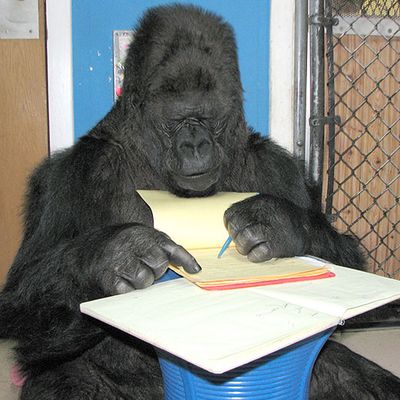
Koko, the western lowland gorilla who died this week at age 46, learned to sign 2,000 words, fell in love with kittens, and became a household name and avatar of the human-animal bond. But apes have always been an obsession of their closest living relatives ÔÇö the subjects of scientific debate and anthropomorphic projection, film, TV and literature, fiction and nonfiction. In honor of Koko we offer this reading list, along with a cute video.
KokoÔÇÖs Kitten, by Francine Patterson and Ronald N. Cohn
KokoÔÇÖs ASL teacher co-wrote this classic childrenÔÇÖs book about the gorillaÔÇÖs bond with the perfect companion ÔÇö followed by a whole brood of little kitty friends. Slightly older kids can move on to the sequel, KokoÔÇÖs Story, about the 14 years Patterson spent teaching her to ÔÇ£speak.ÔÇØ
Gorillas in the Mist by Dian Fossey
This classic memoir by acclaimed primatologist Dian Fossey describes her research in Rwanda, intertwined with her own story. In 1985, two years after the book was published, Fossey was murdered, probably by poachers. Three years after that, Sigourney Weaver played her in a movie adaptation that was nominated for multiple Oscars, including one for Weaver.
Nim Chimpsky: The Chimp Who Would Be Human by Elizabeth Hess
From birth, the chimpanzee Nim was raised with humans, taught to identify with them and use sign language. It was part of a long-term experiment by Herbert S. Terrace, a psychologist at Columbia University. But when funding for the project ran out, Nim was isolated from humanity. This complicated story plumbs the dark side of animal research, even when aimed toward ÔÇ£teachingÔÇØ the animals. It was adapted in 2011 into the acclaimed documentary Project Nim.
The Evolution of Bruno Littlemore by Benjamin Hale
In 2011, Hale took the idea of a chimpanzee living as a human to literary extremes. The novel is narrated by Bruno Littlemore, the first chimp to gain full use of the English language. What he does with it is up to you to find out. (Hint: shelve under romance.) This book explores what would happen if non-humans learned to communicate with us in a way thatÔÇÖs different than Planet of the Apes.
The Murders in the Rue Morgue by Edgar Allan Poe
With this short story, Edgar Allan Poe is widely considered to have created the detective story. Our hero, C. Auguste Dupin, is charged with solving the murders of two women, but the case is thrown for a loop when he realizes the evidence points to an animal culprit. Spoiler: the clue is a clump of orange fur.
Good Night, Gorilla by Peggy Rathmann
Curious George has nothing on this mischievous gorilla from RathmannÔÇÖs childrenÔÇÖs book. While the zookeeper tries to put all the animals to bed, a wily little ape nabs the keys and lets all the animals free.
Congo by Michael Crichton
The author of Jurassic Park tackled a different aspect of the wild in his 1980 novel. After eight geologists mysterious disappear in the fictional Lost City of Zinj, a gorilla named Amy joins an expedition to find the ancient place. Amy ÔÇö whom Crichton based partly on Koko ÔÇö signs her way through the thriller.
Planet of the Apes by Pierre Boulle
The classic French sci-fi novel features a far-away planet where apes are the dominant species and humans are reduced to animals. We have two distinct film franchises to thank for it.
Our Inner Ape by Frans de Waal
You could subtitle┬áthis 2005 work of popular science ÔÇ£Chimps are From Mars, Bonobos are from Venus.ÔÇØ Primatologist Frans de Waal uncovers the characteristics we share with these two closely related species ÔÇö the chimp macho and warlike, the bonobo free-lowing and matriarchal. Somewhat controversially, he claims our social behavior falls somewhere between those extremes.
Ape House by Sara Gruen
In the follow-up novel to GruenÔÇÖs Water for Elephants, a huge best seller whose adaptation starred Robert Pattinson and Reese Witherspoon, Gruen turned her animal gaze on bonobos. A scientist with a lot of love for the primates she works with discovers that she has to learn to get along with humans in order to save them.
Primates of Park Avenue, by Wednesday Martin
In the somewhat cheeky, faux-anthropological account (a book later qualified as partially fiction), the psychologist studies the Upper East Side, habitat of the trophy wife ÔÇö analyzing ÔÇ£the tribeÔÇÖs mating and migration patterns, childrearing practices, fetish objects, physical adornment practices, magical purifying rituals, bonding rites, and odd realities like sex segregation.ÔÇØ A rare example of reverse anthropomorphism.

